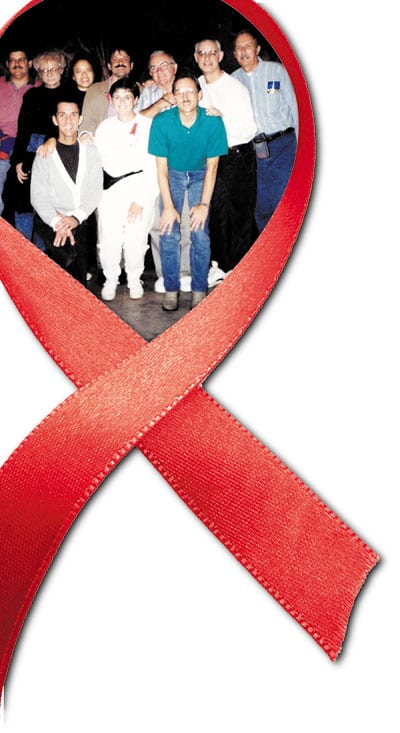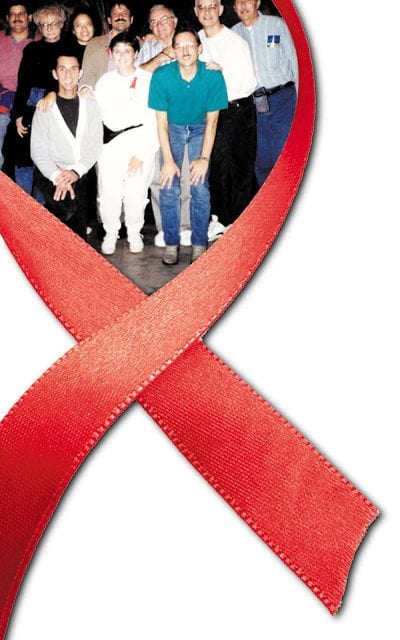From fridges to car repairs, GDMAF has helped those living with HIV and AIDS at critical times
JAMES RUSSELL | Staff Writer
RUSSELL | Staff Writer
The late Greg Dollgener was blunt and gruff. You either liked him or you didn’t.
A Tyler native, Dollgener was living in Dallas in 1989 with his partner. But when Dollgener told his partner he was HIV-positive, the man he had been with for three years told him to move out.
So when he met David Hearn of Plano, Dollgener did not want a repeat of that scenario.
“Greg was a very upfront person,” Hearn recalled. “He told me he was HIV-positive [and] if I had a problem with his status we should stop dating. He wanted to move on if
I wouldn’t date him. He did not want to waste his life with someone who could not accept the situation.”
They dated for three months before Dollgener moved in with Hearn.
But their story didn’t have a happily-ever-after ending, as Dollgener’s HIV developed into full-blown AIDS. Still, even as he succumbed to the virus, Dollgener didn’t lose his cantankerous spirit.
Nor did he lose his commitment to those living with HIV and AIDS.
Dollgener was a member of Oak Lawn Community Services’ Buddies Program. He had a full-time job but “would take his lunch break to take someone to a clinic or doctor’s appointment. He was a giving and caring person,” Hearn said.
He’d also go to Plano-area schools that would allow him in. He’d talk straight with the kids, urging them to be safe and to not be like him.
Dollgener died in June 1994. Hearn regrouped.
Hearn and others started the Greg Dollgener Memorial AIDS Fund, a “fund of last resort” for those with HIV who couldn’t find the immediate help they needed. Next year, the organization celebrates its 20th anniversary.
Last year, Hearn said, GDMAF funds helped a client buy a new refrigerator for their liquid medications. When the client was faced with paying rent or buying a new refrigerator, GDMAF intervened.
The volunteer-run fund fills a specific need, said Tori Hobbs, chief development officer at AIDS Arms, which solicits funds for its clients from GDMAF.
“GDMAF is able to help when no other agency is able to. Something unexpected happens like a refrigerator breaks down. The client might have to chose between getting their prescription filled or fixing the fridge,” Hobbs said. “GDMAF can step in and purchase a fridge ensuring someone can maintain good nutrition.”
Hearn, who has served in various roles with the organization, said he doesn’t know of any other organization like it.
“No other organizations do what we do for those living with HIV and AIDS,” he said.
But despite its singular identity in the community, GDMAF is only now gaining recognition.
“We work closely with organizations like LifeWalk. And 95 percent of all funds raised go to clients. The remaining money is spent on minimal advertising.
Organizations know about us, but then others learn about us,” Hearn said.
The Dallas Bears are one of the organizations aware of GDMAF, naming the fund is primary beneficiary this year.
“The GDMAF has enhanced the lives of people with HIV/AIDS since 1996. We [Dallas Bears] are proud to have [GDMAF] as our 2016 TBRU Primary Beneficiary, as it allows us to play a small part in the compassionate work [it does] on a daily basis,” said Dallas Bears President Gauge Xavier.
Hearn continued, “People are starting to realize the gaps between big organizations and us. We can fill an immediate need with a rapid response. But we are a short-term, one-time organization. We don’t take government funds and are volunteer-run.”
But funds are only released through agency caseworkers. Agencies have resources beyond GDMAF’s scope.
“Agencies serve as screeners,” Hearn said. “We want people to work through a service organization.”
Even with the recent medical advancements allowing people to live fulfilling lives with HIV, there has been more demand for funds. GDMAF’s average disbursement is between $400-500.
“We’ve run out of money around mid-month. When demand is high we can still only take three clients per organizations a month,” Hearn said.
With the help of a variety of groups, GDMAF stays afloat. The annual MetroBall fundraiser helps, too.
The next event is slated for June 3 at Station 4, but the glitzy, star-studded event came from much more humble beginnings.
MetroBall succeeded the casual Plano bar parties. The small gatherings held twice a year at Hearns’ and Dollgener’s home initially benefitted organizers’ friends who were living with HIV and AIDS.
But as the disease spread, the parties became nonperishable food drives for AIDS service organizations across the region.
After grieving Dollgener’s death, Hearn and friends held Plano bar parties once again, eventually outgrowing Hearn’s home.
“I had 200-300 people in my backyard!” Hearn said.
The benefit moved to venues across Cedar Springs beginning in 2006 until finally landing at Station 4.
Hearn hopes increased awareness of HIV and AIDS will eventually make the fund obsolete. Until that day, however, GDMAF will continue to help those most in need.
“We need to make sure [people] get care they need,” Hearn said. “Hopefully we can make a difference, help people in need and also keep Greg’s memory alive.”
……………………….
Statistics on HIV/AIDS Worldwide
• Nearly 37 million people are now living with HIV.
• 2.6 million of those living with HIV are under the age of 15.
• In 2014, an estimated 2 million people were newly infected with HIV.• 220,000 of those newly infected with HIV were under the age of 15.
• Every day about 5,600 people contract HIV; that’s more than 230 every hour.
• In 2014, 1.2 million people died from AIDS.
• Since the beginning of the pandemic, nearly 78 million people have contracted HIV and close to 39 million have died of AIDS-related causes.
• As of March 2015, around 15 million people living with HIV (41 percent of the total) had access to antiretroviral therapy.
The Regional Picture
• In Sub-Saharan Africa:
More than two-thirds (70 percent) of all people living with HIV, or 25.8 million, live in sub-Saharan Africa, including 88 percent of the world’s HIV-positive children. In 2014, an estimated 1.4 million people in the region became newly infected. An estimated 790,000 adults and children died of AIDS, accounting for 66 percent of the world’s AIDS deaths in 2014.
• In Asia and the Pacific:
In Asia and the Pacific, nearly 340,000 people became newly infected in 2014, bringing the total number of people living with HIV there to 5 million. AIDS claimed an estimated 240,000 lives in the region in 2014.
• In the Caribbean:
Approximately 13,000 people became newly infected in the Caribbean in 2014, bringing the total number of people living
with HIV there to 280,000. AIDS claimed an estimated 8,800
lives in 2014.
• In Latin America:
There were an estimated 87,000 new HIV infections and 41,000 AIDS-related deaths in Latin America in 2014. This region currently has 1.7 million people living with HIV.
• In North Africa and the Middle East:
Approximately 240,000 people are living with HIV in this region, and an estimated 22,000 people became newly infected in 2014.
An estimated 12,000 adults and children died of AIDS in 2014.
• In Eastern Europe and Central Asia:
Some 140,000 people were newly infected with HIV in 2014, bringing the number of people living with HIV to 1.5 million. AIDS claimed 62,000 lives in 2014.
• In Western and Central Europe and North America:
In 2014, there were 85,000 new cases of HIV, bringing the number of people living with HIV in Western and Central Europe and
North American to 2.4 million. An estimated 26,000 people in these regions died of AIDS in 2014.
(Source: UNAIDS Report: How AIDS changed everything, 2015; UNAIDS 2014 Global Statistics)
This article appeared in the Dallas Voice print edition November 27 2015.


